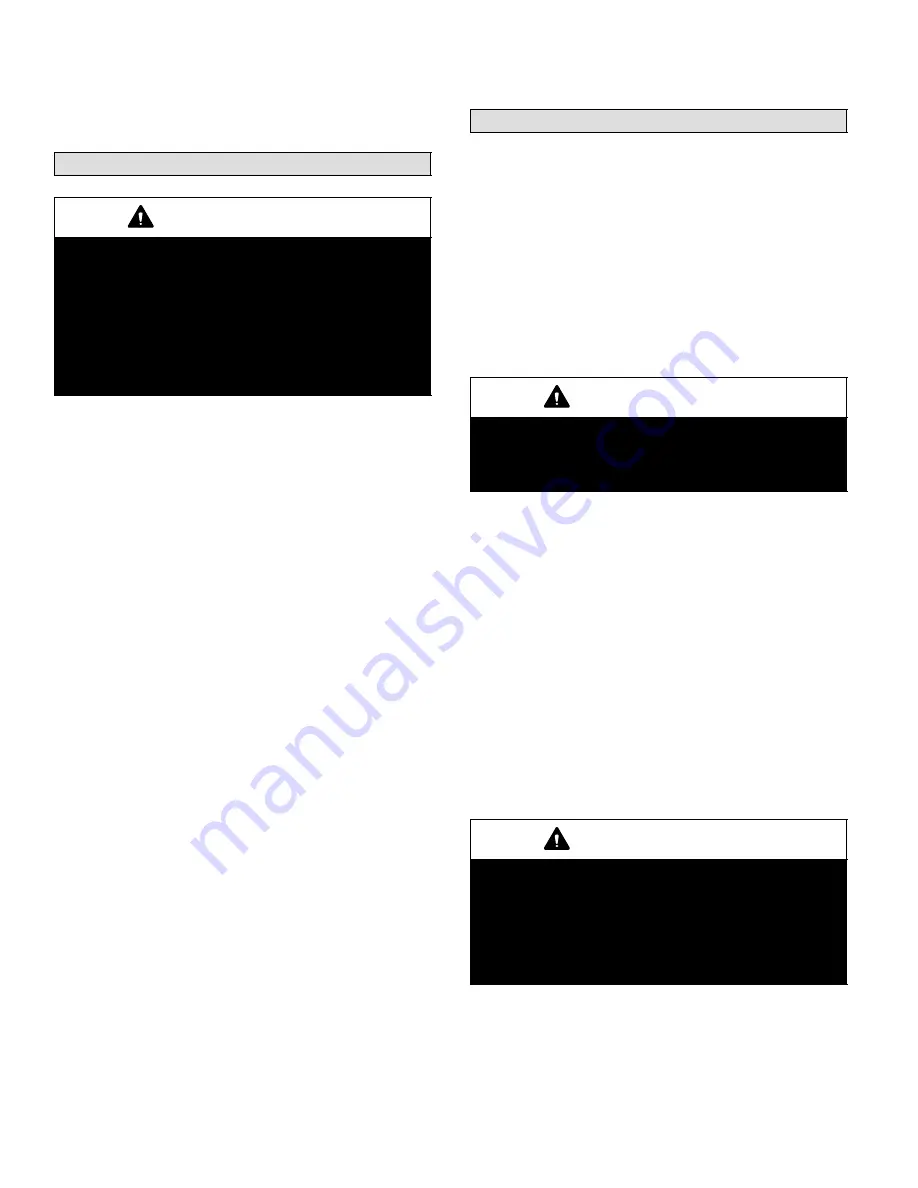
Page 30
505331M 06/09
S
Outdoor unit fan motor is prelubricated and sealed. No
further lubrication is needed.
NOTE If owner reports insufficient cooling, the unit should
be gauged and refrigerant charge checked. Refer to section
on refrigerant charging in this instruction.
Two−Stage Modulation Compressors24
IMPORTANT
This performance check is ONLY valid on systems
that have clean indoor and outdoor coils, proper
airflow over coils, and correct system refrigerant
charge. All components in the system must be
functioning proper to correctly perform compressor
modulation operational check. (Accurate
measurements are critical to this test as indoor
system loading and outdoor ambient can affect
variations between low and high capacity readings).
Use this check-out procedure to verify part- and full-load
capacity operation of two-stage modulation compressors.
TOOLS REQUIRED
S
Refrigeration gauge set
S
Digital volt/amp meter
S
Electronic temperature thermometer
S
On-off toggle switch
PROCEDURE
1. Turn main power OFF to outdoor unit.
2. Adjust room thermostat set point 5ºF above (heating
operation) or 5ºF below (cooling operation) the room
temperature.
3. Remove control access panel. Install refrigeration
gauges on unit. Attach the amp meter to the common
(black wire) wire of the compressor harness. Attach
thermometer to discharge line as close as possible to
the compressor.
4. Turn toggle switch OFF. Install switch in series with Y2
wire from room thermostat (see note ** in the
Field
Operational Checklist
on page 26).
5. Cycle main power ON.
6. Allow pressures and temperatures to stabilize before
taking any measured reading (may take up to 10
minutes).
7. Record all of the readings for the Y1 demand.
8. Close switch to energize Y2 demand. Verify power is
going to compressor solenoid (see note ** in the
Field
Operational Checklist
on page 26).
9. Allow pressures and temperatures to stabilize before
taking any measured reading (this may take up to 10
minutes).
10. Record all of the readings with the Y1 and Y2 demand.
11. If temperatures and pressures change in the direction
noted in chart, the compressor is properly modulating
from low to high capacity. (If no amperage, pressures
or temperature readings change when this test is
performed, the compressor is not modulating between
low and high capacity and replacement is necessary).
12. After testing is complete, return unit to original set up.
Homeowner Information − Maintenance25
In order to ensure peak performance, your system must be
properly maintained. Clogged filters and blocked airflow
prevent your unit from operating at its most efficient level.
1.
Air Filter
Ask your Lennox dealer to show you
where your indoor unit’s filter is located. It will be either
at the indoor unit (installed internal or external to the
cabinet) or behind a return air grille in the wall or
ceiling. Check the filter monthly and clean or replace
it as needed.
2.
Disposable Filter
Disposable filters should be
replaced with a filter of the same type and size.
NOTE − If you are unsure about the filter required for
your system, call your Lennox dealer for assistance.
IMPORTANT
Turn off electrical power to the unit at the
disconnect switch before performing any
maintenance. The unit may have multiple power
supplies.
3.
Reusable Filter
Many indoor units are equipped
with reusable foam filters. Clean foam filters with a
mild soap and water solution; rinse thoroughly; allow
filter to dry completely before returning it to the unit or
grille.
NOTE
The filter and all access panels must be in place
any time the unit is in operation.
4.
Electronic Air Cleaner
Some systems are
equipped with an electronic air cleaner, designed to
remove airborne particles from the air passing through
the cleaner. If your system is so equipped, ask your
dealer for maintenance instructions.
5.
Indoor Unit
The indoor unit’s evaporator coil is
equipped with a drain pan to collect condensate
formed as your system removes humidity from the
inside air. Have your dealer show you the location of
the drain line and how to check for obstructions. (This
would also apply to an auxiliary drain, if installed.)
IMPORTANT
Sprinklers and soaker hoses should not be installed
where they could cause prolonged exposure to the
outdoor unit by treated water. Prolonged exposure
of the unit to treated water (i.e., sprinkler systems,
soakers, waste water, etc.) will corrode the surface
of steel and aluminum parts and diminish perfor-
mance and longevity of the unit.
6.
Outdoor Unit
Make sure no obstructions restrict
airflow to the outdoor unit. Leaves, trash or shrubs
crowding the unit cause the outdoor unit to work harder
and use more energy. Keep shrubbery trimmed away
from the unit and periodically check for debris which
collects around the unit.



































